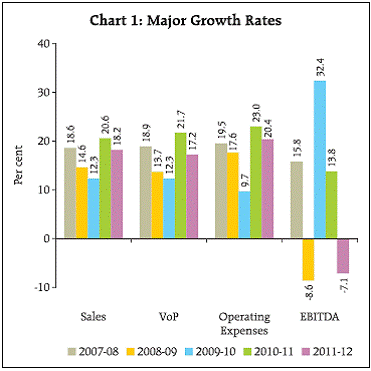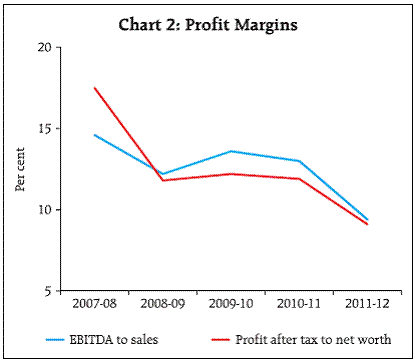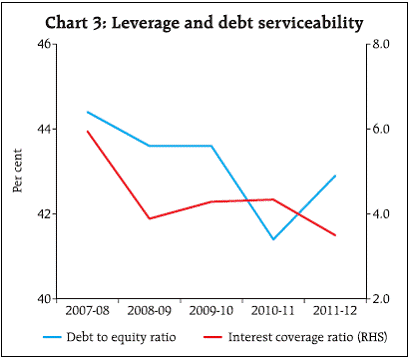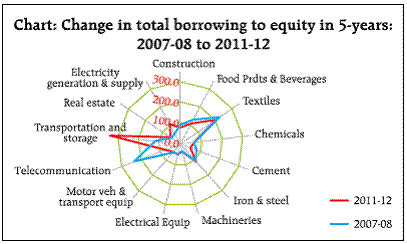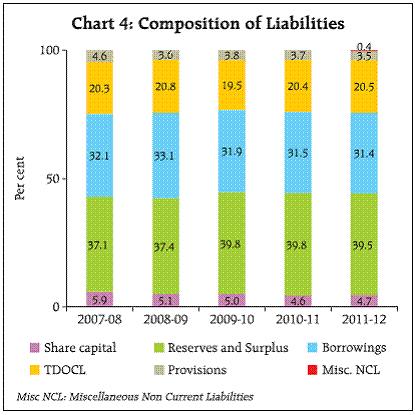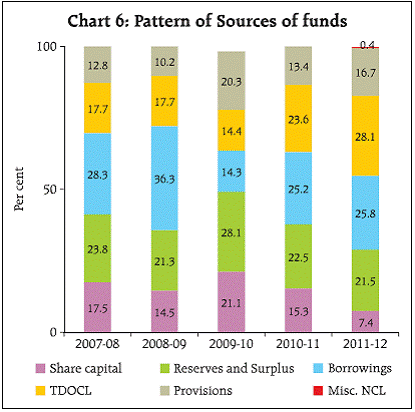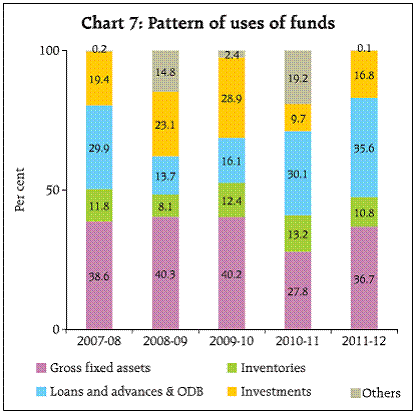Finances of Non-Government Non-Financial Public Limited Companies: 2011-12 - RBI - Reserve Bank of India
Finances of Non-Government Non-Financial Public Limited Companies: 2011-12
Finances of Non-Government Non-Financial Public Limited Companies: 2011-12* The aggregate results of the select non-government non-financial public limited companies in 2011-12 revealed moderation in growth rates of major parameters as compared with those in 2010-11. Relatively higher growth in operating expenses than in value of production resulted in decline in profits viz. earnings before interest, tax and depreciation (EBITDA) and net profits (PAT) and moderation in profit margins as compared to 2010-11. Growth in net worth has been the lowest in last five years. Growth in borrowings also moderated in 2011-12 as compared to 2010-11. The debt to equity ratio increased in 2011-12 reversing a declining trend since 2007-08. Incremental sources and uses of funds during 2011-12 was lower reflecting moderate business activity. However, share of funds used in fixed assets formation was higher in 2011- 12 compared to that in 2010-11. This article presents the financial performance of select 3,041 non-government non-financial (NGNF) public limited companies for the financial year 2011-12 based on their audited annual accounts closed during April 2011 to March 20121 and provides a comparative picture over the five year period from 2007-08 to 2011- 12 based on data compiled for the relevant financial years and published earlier. The detailed data for 2011- 12 have been made available in the website of the Reserve Bank. The select 3,041 companies covered in the latest data release accounted for 30.5 per cent of population paid-up capital (PUC) (provisional estimate supplied by Ministry of Corporate Affairs, GoI) of all NGNF public limited companies as on March 31, 2012. The coverage of companies for earlier years was slightly different. A study based on a smaller sample (1,843 companies) of only large (paid up capital (PUC) above `10 million) NGNF public limited companies with PUC coverage of 23.3 per cent was published in the RBI Bulletin in March 2013. This study provides an updated position based on a larger set of companies. The broad observations from the current analysis are similar to those published in the earlier study. 1. Weak demand conditions led to lower profits 1.1 Growth in sales of select NGNF public limited companies moderated in 2011-12 (18. 2 per cent) as compared with 2010-11 in line with lower economic growth (Statement 1 and Chart 1). Growth in operating expenses also moderated but was relatively higher than the growth in value of production (VoP). Consequently, earnings before interest, tax, depreciation and amortization (EBITDA) declined. Continued and high growth in interest expenses caused sharper fall in net profits (PAT) in 2011-12. Lower profit led to lower growth in dividend payment by the select companies in 2011-12. 1.2 Performance of bigger companies, with sales ‘`10 billion and above’ each, was relatively better as they recorded marginally lower sales growth and smaller decline in profits. Performance of companies in all other sales size-groups deteriorated much more in 2011-12. In the case of companies with sales ‘less than `1 billion’ each, aggregate sales declined. 1.3 At the sectoral level, services sector recorded sharp moderation in sales growth while the construction sector recorded some improvement in 2011-12. EBITDA declined in all the sectors but it could be better contained in the services sector. ‘Electricity generation and supply’ industry recorded significant contraction in EBITDA in 2011-12 on the back of 25 per cent fall in the previous year. 1.4 In the manufacturing sector, ‘chemical and chemical products’, ‘cement and cement products’ and ‘iron and steel’ industries registered higher sales growth in 2011-12. ’Electrical machinery and apparatus’, ‘cement and cement products’ and ‘food products and beverages’ industries recorded substantial growth in EBITDA. EBITDA in ‘iron and steel’ and ‘motor vehicles and other transport equipments’ industries also increased. On the other hand, higher operating expenses in the ‘chemical and chemical products’ and ‘pharmaceuticals and medicine’ industries and significant moderation in sales growth in ‘textiles’ and ‘machinery and equipment (non-electrical)’ industries led to considerable decline in EBITDA. 1.5 In the services sector, companies in ‘transportation’ and ‘real estate’ industries recorded sharp fall in sales growth and EBITDA. ‘Computer’ and ‘telecommunications’ industries, contrary to the general trend, registered improved growth in EBITDA in 2011-12. 2. Profit Margin declined to the lowest level in post crisis period 2.1 EBITDA margin of Indian corporates came off the peak attained in 2007-08 (14.6 per cent). After a decline in 2008-09 during global financial crisis, the margin remained stable till 2010-11 but fell sharply in 2011-12 reaching a level (9.2 per cent) much below that of the crisis year (Chart 2). The margin contraction is mainly attributed to fall in pricing power of the corporates in poor demand condition. The return on equity (PAT to net worth ratio) also depicted similar pattern. 2.2 Larger the sales-size, higher was the EBITDA margin in all the five year period under consideration. However, EBITDA margin declined across all the sales-size groups in 2011-12 and it was the lowest in last five years except for companies in the smallest sales-size group (i.e. with sales ‘less than `1 billion’ each). 2.3 Compression in the EBITDA margin in the services sector was the lowest and in the ‘electricity generation and supply’ industry was the highest. Construction and manufacturing sector also recorded significant fall in EBITDA margin. EBITDA margin of the select companies in the ‘machinery and equipment (non-electrical)’ industry turned negative in 2011-12 as they made loss in aggregate. Besides, the ‘chemical and chemical products’ industry in the manufacturing sector and ‘transportation’ industry in the services sector also suffered sharp decline in the EBITDA margin. 3. Business expanded at a slower pace 3.1 Total net assets of selected companies grew at the lowest rate in 2011-12 during last five year period (Statement 2). The deceleration was spread across all sales-size classes and it was more significant for the bigger companies which showed some signs of recovery in 2010-11. 3.2 Services sector registered the lowest growth in total net assets reflecting problems in ‘telecommunications’ and ‘real estate’ industries. Manufacturing sector also expanded at a much lower rate. 3.3 Lower growth in total net assets in 2011-12 as compared to the previous year was seen in most of the industries. However, ‘chemical and chemical products’ and ‘iron and steel’ industries in manufacturing sector and ‘transportation’ and ‘computer and related activities’ industries in the services sector grew at higher rates. 3.4 Total net assets also grew at a slower rate in 2009- 10. However, an important difference in 2011-12 was in the funding of such assets. Net worth of corporates grew at a healthy rate in 2009-10 aided by higher growth in profits. But, borrowings grew at a much lower rate. In comparison, growth of borrowings kept pace with that of assets in 2011-12. However, net worth grew at a much lower rate reflecting lower accrual in profit and adverse capital market condition. Net worth growth suffered most in the services sector with ‘transportation’ industry worst hit due to large losses. 4. Leverage increased while interest coverage declined 4.1 In general, borrowings grew at much lower rates in line with slower business expansion in 2011-12 compared with 2010-11. However, borrowings of ‘machinery and equipment (non-electrical)’ and ‘construction’ industries grew at higher rates along with that of ‘electricity generation and supply’ industry. 4.2 Leverage of corporates, as measured by debt (consisting mostly of long-term borrowings) to equity ratio, had fallen gradually by three percentage points between 2007-08 and 2010-11 (Chart 3). However, the debt to equity ratio increased in 2011-12, on account of steeper moderation in the growth in net worth as compared with that of debt. The increase in leverage in 2011-12 has also been observed in some alternative measures (Box 1). Box 1: Corporate leverage – Alternative indicators Leverage of corporate is commonly measured in terms of debt to equity ratio. Debt generally refers to long term mortgaged liability of a company and excludes short term borrowings or borrowings of current nature. However, these excluded items of borrowings while calculating debt constitute 37 per cent or more of total borrowings in recent years. Thus, it may be worthwhile to study the trend in leverage of Indian corporates through total borrowings to equity ratio. The trend, however, in terms of total borrowings to equity ratio was similar to that observed in terms of debt to equity ratio except that it is higher on dimension due to obvious inclusion of all items under borrowing. The total borrowings to equity ratio, at aggregate level, declined from 77.7 per cent in 2008-09 to 69.0 per cent in 2010-11 and then increased in 2011-12 to 71.0 per cent. It may be observed from the chart that leverage increased significantly in ‘transportation and storage’ industry. ‘Electricity generation and supply’ industry also displayed increase in leverage in last five year period. On the other hand, ‘telecommunications’ industry recorded considerable fall. Leverage in other major industries remained more or less stable. ‘Textiles’ and ‘iron and steel’ industries continued to operate with high leverage. Another growing concern as regards to leverage of corporates is whether it is higher when seen based on consolidated accounts compared with that based on standalone accounts. In its consolidated accounts statements, financial statements of subsidiaries are also included and an aggregate position is presented after eliminating all inter-firm transactions. Higher leverage in consolidated accounts than in standalone accounts will indicate that the subsidiaries are more leveraged. An analysis based on 491 companies2 showed that the leverage of the consolidated accounts is much higher than that of the standalone companies both in 2010-11 and 2011-12. The total borrowings to equity ratio of the select companies on standalone basis rose from 60.8 per cent in 2010-11 to 63.0 per cent in 2011-12 while that on consolidated basis rose from 85.7 per cent to 94.8 per cent in the same periods. This clearly indicates that not only the leverage is higher in consolidated accounts, the difference has also increased in 2011-12. 4.3 In addition to increase in leverage, the ability to service debt, as measured by interest coverage ratio (EBIT to interest ratio), fell sharply and reached the lowest level (3.5) in 2011-12 during last five years. 4.4 Companies in the sales-size group ‘`5 billion – `10 billion’ each had the highest debt to equity ratio during the five year period except in 2011-12 (Statement 2). Leverage in ‘electricity generation and supply’ sector increased significantly in 2011-12 in line with higher growth in borrowings. Manufacturing sector also recorded higher debt to equity ratio mainly contributed by ‘textiles’, ‘cement and cement products’, ‘chemical and chemical products’ and ‘iron and steel’ industries. In the services sector, though leverage continued to fall marginally at the aggregate for second consecutive year, significant increase in debt to equity ratio was observed in ‘transportation’ industry. 5. Gradual decline in share of net fixed assets 5.1 Broad composition of liabilities remained almost unchanged in the last five years except that share of ‘reserves and surplus’ increased by about 2 percentage points in 2009-10 with concomitant decline in the share of ‘borrowings’ (Statement 3A and Chart 4). Share of borrowings from banks in total outstanding liabilities declined by 1.3 percentage points in 2011-12. 5.2 On the assets side, share of ‘net fixed assets’ in total assets has gradually declined during the five year period. Share of ‘loans and advances and other debtor balances’, which declined during the crisis year, has been on upward move since 2010-11 (Statement 3B and Chart 5). Increase in the share of ‘loans and advances and other debtor balances’ in 2011-12 was partly due to the increase in ‘sundry debtors’. On net basis, amount receivable from ‘sundry debtors’ was more than amount payable to ‘sundry creditors’. The select companies’ financial investments also rose since 2008- 09 and its share reached a high of 18.8 per cent. 6. Share of fixed assets formation in uses of funds increased 6.1 Total sources and uses of funds during the year 2011-12 was lower than that in 2010-11 substantiating the slower business activity during the year. Funds raised by the corporates during 2011-12 continued to be dominated by external (i.e. other than companies’ own) sources of funds, though, its share declined from 63.6 per cent in 2010-11 to 61.7 per cent in 2011-12 (Statement 4A and Chart 6). This was mainly due to sharp drop in the ‘premium’ received on fresh issue of shares in lukewarm capital market. Share of funds raised through ‘trade dues and other current liabilities’ (TDOCL) increased to 28.1 per cent in 2011-12 as compared with 23.6 per cent in 2010-11. 6.2 Gross fixed assets formation was lower during 2011-12 but its share increased as compared with 2010- 11 (Statement 4B and Chart 7). The share of ‘loans and advances and other debtor balances’ in uses of funds rose further in 2011-12. Also, share of ‘investments’ which declined sharply in 2010-11 rose in 2011-12.
* Prepared in the Company Finances Division of the Department of Statistics and Information Management. Reference may be made to the June 2012 issue of the RBI Bulletin for the previous year study. In the present study, 460 new companies have been covered in addition to the 2,581 companies common with the previous study. Data of some of the companies in the sample were procured from Centre for Monitoring Indian Economy (CMIE). 1 In the case of companies, which either extended or shortened their accounting year, their income, expenditure and appropriation account figures have been annualised. The balance sheet data, however, have been retained as presented in the annual accounts of the companies. The analysis of financial performance of the select companies is subject to these limitations. |
|||||||||||||||||||||||||||||||||||||||||||||||||||||||||||||||||||||||||||||||||||||||||||||||||||||||||||||||||||||||||||||||||||||||||||||||||||||||||||||||||||||||||||||||||||||||||||||||||||||||||||||||||||||||||||||||||||||||||||||||||||||||||||||||||||||||||||||||||||||||||||||||||||||||||||||||||||||||||||||||||||||||||||||||||||||||||||||||||||||||||||||||||||||||||||||||||||||||||||||||||||||||||||||||||||||||||||||||||||||||||||||||||||||||||||||||||||||||||||||||||||||||||||||||||||||||||||||||||||||||||||||||||||||||||||||||||||||||||||||||||||||||||||||||||||||||||||||||||||||||||||||||||||||||||||||||||||||||||||||||||||||||||||||||||||||||||||||













